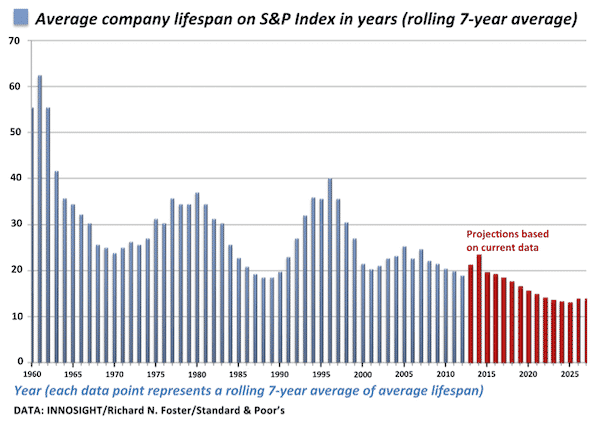Large companies have never been able to occupy a significant place in the market if they focused exclusively on coming up with new products. I’m not talking about inventing a new taste of ketchup or coffee with whipped cream. I mean taking the market for decades. I think about the taking the market for years due to a breakthrough product or service that turned out to be so innovative that it quickly gained immense popularity.
It is no secret that a century ago the average time of the company’s reign on the Fortune 500 list was 75 years. Today everything has been drastically shortened. The enormous competition, the democratization of information and the speed of cooperation have caused that the company’s life has dropped to 15 years (Please have a look at Figure 1).
Figure 1. Average company lifespan (historical data and trend)

Big companies are not designed to be innovative. These companies are created to perform tasks in a very repetitive manner. Why? If Heinz or another producer has fixed distribution channels. Let us remember that the company invested a lot of effort and money in these channels. The company has no interest in bypassing these channels. That’s why more ketchup flavors are created, and disruptive innovation appears very rarely.
If your corporation wants to innovate in such a way as to increase the company’s value, optimize the margin to make it more valuable for the company’s shareholders, it’s worth looking at the Xerox example.
I will do STOP for a moment and I will take you about 15 years earlier, to the ’70s.
Charles McColough, CEO and co-creator of XEROX knew that the future of computers will be different. He sensed computers will be commoditized. He understood that they were too expensive, complicated and the average citizen would not be able to serve them. Charles decided to set up a special group that he did not place at the Xerox headquarters intentionally. He provided the group with money, tools and freedom of action. What was the purpose? Solve the great problem of humanity, or a graphical interface, a computer understandable to the average citizen and handled in a simpler way.
Results?
- personal computer;
- graphic interface;
- computer mouse;
- Ethernet;
- laser printer;
Xerox had amazing products.
At the same time, competition began to appear. Xerox had an advantage over Canon (the most powerful competitor then). Then Xerox made a mistake. Company teams started selling new products (remember that they were very groundbreaking) through the same distribution channels that they used for a long time before. They simply didn’t test and discover new business model. So much effort was invested in discovering new technologies, that company lost time and money (investors lost patience) and teams were not prepared for experimenting with business model.
Who used the combination of these technologies and an innovative business models?
Apple. Amazon. IBM. These companies (their leadership teams) understood very quickly that it is not enough to have a breakthrough product or service. It needs to be synchronized with an innovative business model.
The innovative business model requires hundreds of experiments with clients. Do not get me wrong. These are not experiments on clients. These are experiments with clients. Figure 2 shows the number of market experiments undertaken by the most innovative companies in the world.
Figure 2. Number of experiments led by Intuit, P&G, Google, Amazon, Netflix (Source: Jeff Bezos letter to shareholders, Wisconsin State Journal, BCG.com, Google.com and Sec.gov).

From the XEROX example, I can recommend you these takeaways:
- Assign patient budget for the innovation development.
- Separate innovative projects (team, procedures and structure) from corporate culture.
- Aim at huge challenges and big problems.
- Hire best people.
- The most important – focus on new products / services and business models. Discovering innovative technologies is not enough.
——————
About me:
I work (on both sides of The Atlantic Ocean) with global brands on digital growth, launching new digital products and services as well as on crafting digital ventures between corporation and startups.
Customers who trust me and whom I respect very much: Danone, Shell, Discovery Networks, P&G, LaGardere, Roche, IKEA, Bayer.

